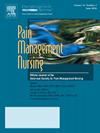Multi-Method Pain Management Education for Nurses
IF 1.6
4区 医学
Q2 NURSING
引用次数: 0
Abstract
Lack of pain management education in nursing schools and absence of a formal pain management education for nurses at this organization, prompted the development of a pain mentor program. The pain mentor program for bedside clinical nurses, initially started in 2018, includes a full day interactive education using didactic, simulation based, and hands-on methods.
Simulation has been shown to be an effective teaching method to improve self-confidence and clinical performance in addition to enhancing critical thinking. Repeated simulation can aid in decreasing state of anxiety, thus reducing medical error tendency levels. Another benefit of using simulation on nursing education is the incentive to develop a caring behavior towards patients.
During didactic and standardized patient simulations, learners discuss pain management practices within a safe simulation-based environment, evaluate effective communication techniques, create opportunities for patient participation in the pain management plan of care, and understand how to perform a thorough pain management assessment.
During the hands-on session learners apply gained knowledge to the variety of available pain management pumps, evaluate pump programming scenarios for accuracy or necessary reprogramming, and analyze the overall documented pain management plan of care in the medical record.
To evaluate the effectiveness of the educational program in 2022, attendees were provided with a survey. One hundred percent of nurses responded that the education would help improve patient care because they were better prepared to discuss pain management principles for acute, chronic, and acute on chronic pain and through better understanding of pain management principles learned through simulation. When asked how the education would change practice greater than 50 percent responded that they would be able to work more effectively, better interact with patients and improve quality.
Feedback on the education program was overwhelmingly positive. Measuring the impact of pain management education on patient care would require research and further investigation.
求助全文
约1分钟内获得全文
求助全文
来源期刊

Pain Management Nursing
医学-护理
CiteScore
3.00
自引率
5.90%
发文量
187
审稿时长
>12 weeks
期刊介绍:
This peer-reviewed journal offers a unique focus on the realm of pain management as it applies to nursing. Original and review articles from experts in the field offer key insights in the areas of clinical practice, advocacy, education, administration, and research. Additional features include practice guidelines and pharmacology updates.
 求助内容:
求助内容: 应助结果提醒方式:
应助结果提醒方式:


